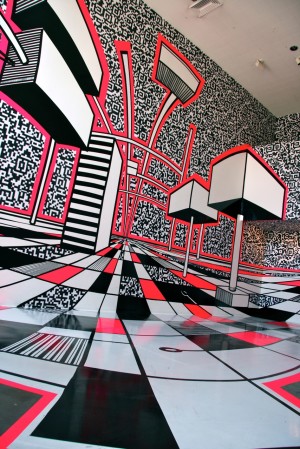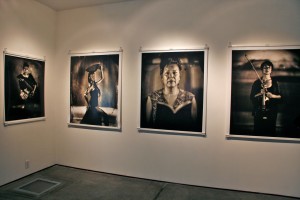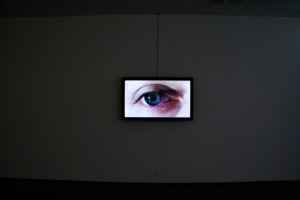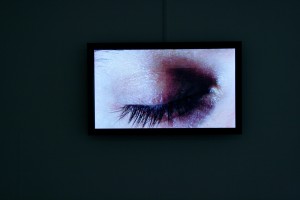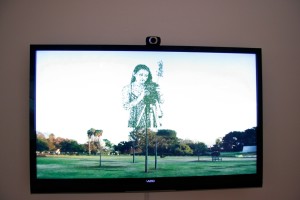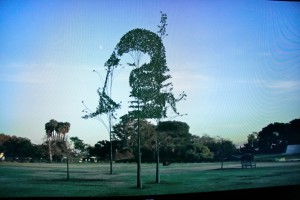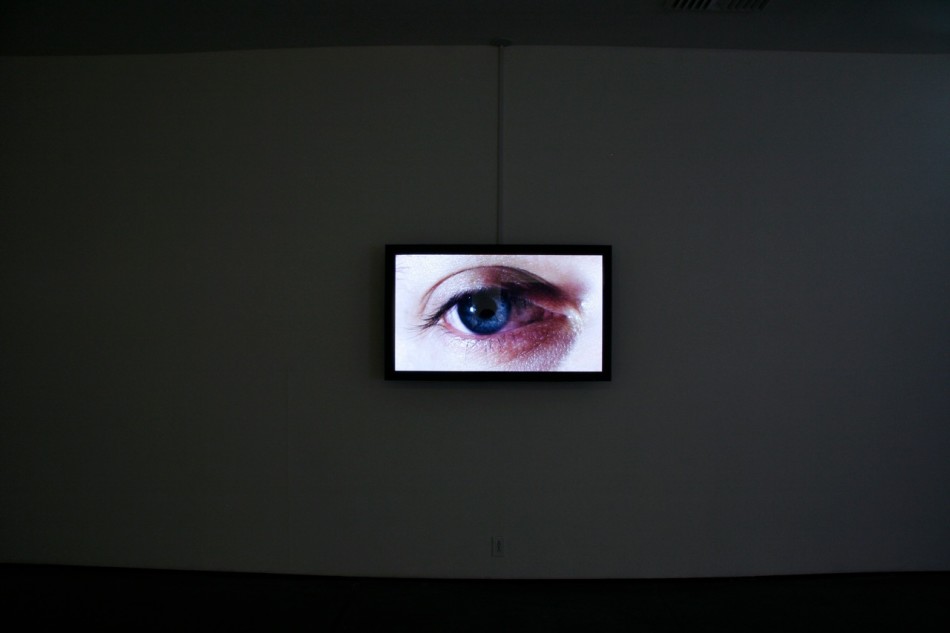
Rafael Lozano-Hemmer Surface Tension 1992 Plasma screen, computerized surveillance system, custom-made software Courtesy of bitforms gallery, nyc
Albuquerque’s “Digital Latin America” Etches Parallel Visions
The kickoff of “Digital Latin America,” headquartered at the nonprofit 516 Arts with satellite venues across Albuquerque, N.M., arrived during a hot week in June. As with most opening parties, the clamor and crowd noise weren’t ideal for taking in the featured art in the gallery. Still, the street fair staged on a roped-off block of Central Avenue did set a populist tone for the summer-long exhibition.
Gawking stilt-walkers swaying to loud music mingled among kids in strollers and bar-patio denizens who also got to witness several of the artists performing amid waves of food-cart smoke. El Paso-based Jessica Pizaña Roberts, dressed in “traditional” Mexican clothing, ladled out bowls of beans to passersby. In fact, her supper offerings were an extension of the work she’d installed inside 516; the costuming mimicked the “Rosarita” emblem stamped on tin-canned ConAgra labels of “readymade” Mexican foods. The performance, like Pizaña Roberts’ “Ay, Papi” video loop featured in the exhibition, embodied how the most basic elements of culture are subject to grotesque distortions of stereotyping, marketing and commodification.
It also demonstrated how new media forms have rewired traditional means of presenting art to the public. Walls between artist and audience as well as artist and gallery are dissolving. And gaps between artists themselves — formerly stretching across vast geographical territories — are shrinking.
The curators of “Digital Latin America” were mindful of these shifts, building on the momentum of 2012’s International Symposium on Electronic Art in Albuquerque, which featured a special forum centered on art and technology throughout Latin America. (Topics ranged from the SEFT-1 “Manned Railway Exploratory Probe” in Mexico to Spanish-language pirate radio in Lafayette, Ind.) Feedback on ISEA was so enthusiastic that 516 Arts staff, among the local groups that collaborated to bring the international festival to Albuquerque, decided to design a follow-up event focused solely upon artists spanning the region.
“Digital Latin America” coincides with a surge of interest in Latin America by U.S. museums and art centers — a shift which curator and art historian Cecilia Fajardo-Hill described to ArtNews in May as “the U.S. recognizing the incredible relevance of Latin America and Latino culture on our continent.”
On July 18, SITE Santa Fe opens “SITElines,” the first of three biennial exhibitions dedicated to art of the Americas. A little further afield, the Getty in Los Angeles is scheduled in 2017 to launch “Pacific Standard Time: LA/LA,” tracing Southern California’s artistic lineage with greater Latin America.
There is, of course, the ever-present danger for an event themed along geographical lines to devolve into uncritical local boosterism, or to relegate its contents to what José Roca, adjunct curator at the Tate in London, referred to in a talk last year at Art Basel Miami https://www.youtube.com/watch?v=E20uiJW9DFw as a “geographical ghetto” relegated to margins of the mainstream.
The diversity of selections included in “Digital Latin America,” combined with deft curatorial tracing of layered intersections between artists from disparate homelands, defy both. Responsive plasma-screen portraiture by Colombian programmer Javier Villegas deftly parallels the spooky surveillance of Mexican Rafael Lozano-Hemmer’s “Surface Tension,” initially created for a political theater performance.
The tendency of strong digital work to include viewers in intimate, time-intensive ways, further resists shallow interaction. “Maquila Región 4,” by Mexico City’s Amor Muñoz, portrays the process of a mobile, pedal-powered workshop that recruited and employed skilled, out-of-work maquila laborers in the fabrication of what Muñoz calls “textile-schematic” circuitry. The finished fabric is smartphone-enabled to transmit stories about the workers themselves. Audience members are thus provided several means of exploring the project’s underlying social commentary about the value of humane work versus the cost of cheap labor.
Behind the Digital Scenes
Teresa Buscemi, El Salvador-born program coordinator at 516 Arts, co-led the exhibit curation with Executive Director Suzanne Sbarge. She says that, with its strong histories of both scientific and artistic innovation, New Mexico is an ideal place for cutting-edge artists situated along a north-south axis to engender deep collaboration.
Buscemi points to the massive site-specific work installed by Jessica Angel, “Hemispherical Immersion II.” The piece employed analog tools and methods to create an immersion into Angel’s imagined version of cyberspace. New Mexico-based artists labored alongside Angel as interns over the course of three weeks to install the work, a cross-pollination that’s among the exhibition objectives.
The result is like setting foot onto a video game landscape, only the pixelated topography feels obsessively hand-built. The giddy, panoramic effect, with bright seizes of fluorescence, verges on nightmarish.
Buscemi says the “interactivity and reactivity built into the nature of these works” can help audiences consider the consequences — and subversive capabilities — of technology, too typically understood as ubiquitous, banal and inevitably useful. She adds that inviting the public to think critically about creative purposes for new devices is key to engendering a future of interdisciplinary innovation linking education, science, tech and art.
Most riveting are the lines of kinship exposed by convening these pieces. Diné photographer Will Wilson’s contemporary tintype images (embedded with a layer of interactivity via phone-scanability using the free app Layar) provide living parallels to Gabriel Vanegas’ self-described “media archeology.” Brazilian design duo Cantoni & Crescenti’s “Speak/Fala” inserts a branch of discourse about mutability and language. Its automated talking machines, which take their cues from a human speaker before spiraling into their own conversation, create another lyrical, alphabetized form of communication that echoes, then evaporates, into the surrounding space.
Other binding threads might be more detectable by locals who visit the show. The Daniel Langlois Foundation’s listening station equipped with a vast historical compendium of Latin American electric-acoustic compositions provides a glimpse into some of the experimental precursors to Albuquerque’s cadre of respected noise musicians. Wander the cool, cavernous darkness framing the work of Colombian Oscar Muñoz at the satellite exhibition hosted by the University of New Mexico Art Museum. There’s a shiver of recognition as his projected images — inked faces floating atop draining water — ebb into distortion, then re-coalesce. These could easily be the visages of our own disappeared and cast away. (Recall, for example, the macabre unsolved mystery of Albuquerque’s West Mesa murders.) Their open gazes remind us of our obligation not just to remember, but to engage.

